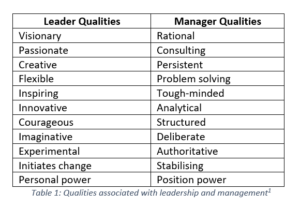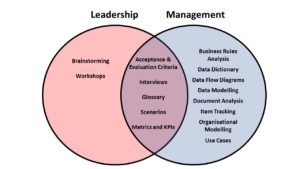
A Natural Born Manager
Everyone, it seems, wants to be recognized for their leadership abilities. ‘Leader’, ‘leading’ and ‘leadership’ are in vogue terms for CVs and professional social media profiles. Everywhere you look, there are books, articles, and presentations on the topic, and leadership courses abound. Indeed, being called a ‘natural born leader’ is considered a high compliment. But could this obsession with leadership be at the expense of other, possibly more important qualities?
This article will look at some of the characteristics associated with leadership and management, the role they play in defining and driving organizational change, and what they mean to business analysis.
Leadership vs. Management
The table below lists qualities often attributed to leaders and managers respectively.

You can find similar lists each lauding slightly different traits, but they all share the same sentiment – leadership is about inspiration, innovation, and change, while management is about structure, problem-solving and routine. For some, leadership is something an individual possesses innately – a natural tendency, as opposed to a skillset that can be learned and improved. Management, on the other hand, is usually viewed more as a skill set that is developed over time and with experience. But are they really that different? And can one set of qualities be used to accentuate the other?
Leadership and Management in Times of Change
For an organization undergoing transformational change, there is no denying leadership is important. Having a charismatic leader who can articulate a vision to a wide audience can make the change journey easier. But organizations do not need many leaders. For most organizations, a single, visionary leader may be enough. Indeed, having too many leaders may be detrimental to an organization, particularly if the leadership group is unable to agree on a single, coherent vision.
- Leadership does not guarantee change success. Indeed, leadership in the absence of management capabilities is unlikely to result in successful change.
- Measures of change success are likely to draw on management qualities. A change is only successful if it can be embedded and maintained over time… or in other words, whether it results in a level of stability – a quality associated with management.
It is important to remember that leadership and management are not mutually exclusive. Indeed, good managers will often have leadership qualities, and good leaders certainly require management skills. In some instances, the distinction between leaders and managers may not be clear. Individuals may be required to move between roles depending on the situation, particularly in more agile or dynamic contexts.
Business Analysis: Leadership, or Management?
Business analysis is often at the forefront of efforts to translate the vision of leaders into maintainable solutions. As such, the good analysis may be confounded with leadership. Analysis that is produced through wide consultation succinctly describes the situation and context, considers different perspectives, and clearly communicates a solution may be able to achieve more in envisioning and driving change than anyone recognized as a ‘leader’. Yet, it would be wrong to diminish the contribution of an analyst’s management capabilities in the delivery of such analysis. A good analysis involves problem solving, persistence, and structure – all qualities associated with management. And should that analysis lead to the implementation of an innovative, proactive solution – Is that leadership? Or just a by-product of good management?
A range of techniques is available to assist Business Analysts in delivering quality analysis. If we look at the available techniques, many of them epitomize management qualities. Take for example the 15 business analysis techniques in the Business Analysis Book of Knowledge (BABoK)2 that are sometimes considered the core techniques. Figure 1 shows these techniques on a Venn diagram based on whether they generally accentuate management or leadership qualities:

Figure 1: Core Techniques of the BABoK
This diagram shows the majority of these techniques on the management side of the Venn diagram as they involve analyzing and structuring information – qualities associated with management. There are some techniques that are more flexible and can be employed to promote innovation and experimentation – more traits associate with leadership, and others that can emphasize different qualities depending on the context. This is good news for Business Analysts who want to improve and expand their capabilities into different areas or contribute to an initiative in a different way – there is usually a technique that can help.
Of course, Business Analysts also require underlying competencies across a number of areas. The BABoK includes a whole set of competencies grouped under the heading Analytical Thinking and Problem Solving, which are qualities (as per Table 1) associated with management. However, the BABoK also lists creative thinking, adaptability, and even leadership and influencing as underlying business analysis competencies – qualities associated with leadership.
At the end of the day, even the most revered business analyst ‘leader’ is likely to extol management qualities over leadership qualities as that is the nature of the analysis. For example, any Business Analyst with a new, innovative, or interesting idea is likely to immediately start asking questions such as:
- Is there a business need?
- What is the impact of the change?
- What does success look like?
…and, thus, immediately start analyzing and creating structure. In the end, we can’t get away from the fact that business analysis is focused on the delivery of viable solutions to problems. Therefore, while leadership qualities may be an asset to a Business Analyst, management capabilities are fundamental to business analysis.
Conclusion
The intention of this article is not to deride leadership qualities or diminish their value. Indeed, leadership skills are important, and I would encourage any Business Analyst to work on developing their leadership capabilities. However, focusing on leadership is not healthy. Over-emphasizing the importance of leadership can be at the expense of other qualities and detract from the core capabilities required to elicit and understand requirements, analyze solution options, drive change, and support sustainable services – things that are fundamental to business analysis.
I, for one, would consider it a compliment to be called a natural-born manager.
Resources:
- Capowski G., Anatomy of a leader: Where is the leader of tomorrow?, Management Review Vol. 83 Issue 3, 1994, p. 10-18.
- Business Analysis Book of Knowledge v3, Institute of Business Analysis, 2015.